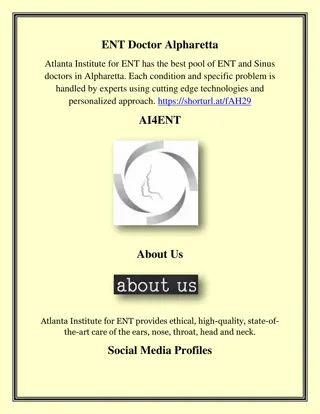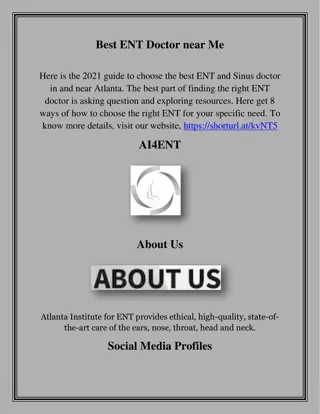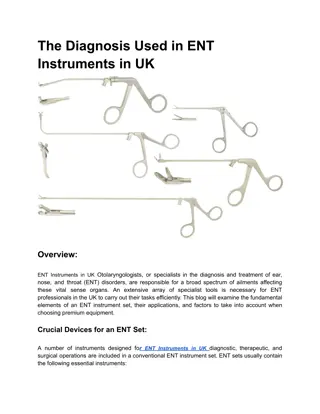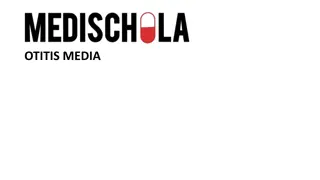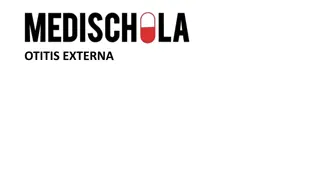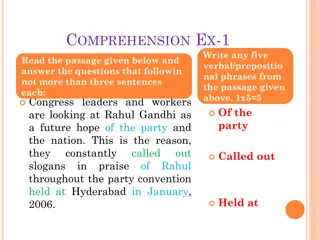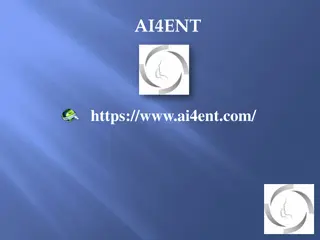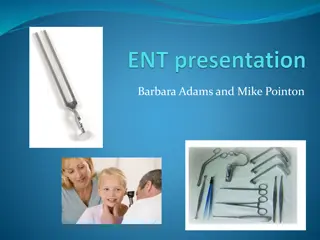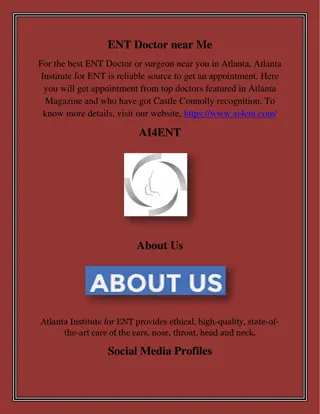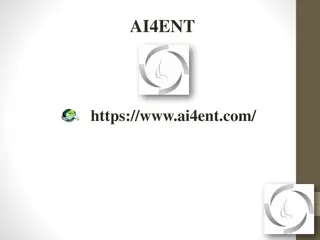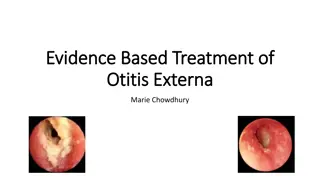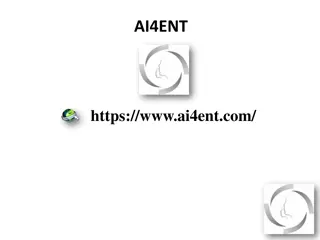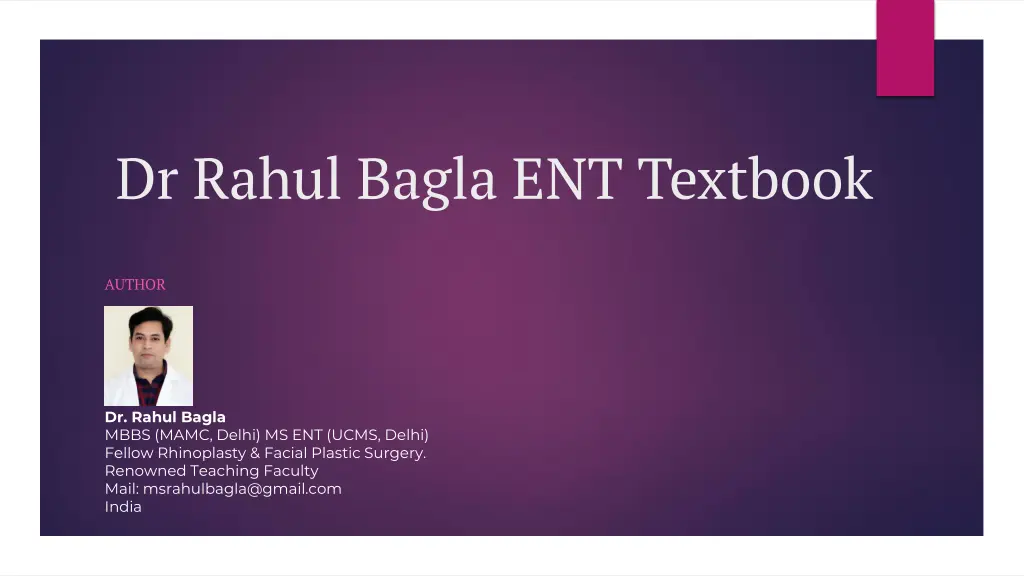
Understanding Acute Suppurative Otitis Media in ENT Practice
Dive into the world of Acute Suppurative Otitis Media (ASOM) with Dr. Rahul Bagla, a renowned ENT specialist. Discover the common ear infection affecting children and adults, its defining characteristics, triggers, microbial causes, and potential complications like mastoiditis. Explore the insights provided by Dr. Rahul Bagla, an esteemed author and teaching faculty in the field of otolaryngology.
Download Presentation

Please find below an Image/Link to download the presentation.
The content on the website is provided AS IS for your information and personal use only. It may not be sold, licensed, or shared on other websites without obtaining consent from the author. If you encounter any issues during the download, it is possible that the publisher has removed the file from their server.
You are allowed to download the files provided on this website for personal or commercial use, subject to the condition that they are used lawfully. All files are the property of their respective owners.
The content on the website is provided AS IS for your information and personal use only. It may not be sold, licensed, or shared on other websites without obtaining consent from the author.
E N D
Presentation Transcript
Dr Rahul Bagla ENT Textbook AUTHOR Dr. Rahul Bagla MBBS (MAMC, Delhi) MS ENT (UCMS, Delhi) Fellow Rhinoplasty & Facial Plastic Surgery. Renowned Teaching Faculty Mail: msrahulbagla@gmail.com India
Acute Suppurative Otitis Media AUTHOR DR RAHUL BAGLA
Acute Suppurative Otitis Media: A Common Ear Infection ASOM is a rapid-onset bacterial infection of the middle ear cleft. Most common in children aged 6 24 months due to eustachian tube anatomy.
Defining Acute Suppurative Otitis Media ASOM is an acute (lasting <3 weeks) pyogenic inflammation of the middle ear cleft, including the eustachian tube, attic, and mastoid air cells. Primarily affects children due to shorter, wider, more horizontal eustachian tubes. Often develops behind an intact tympanic membrane but can involve perforations or ventilation tubes.
Link to Mastoiditis ASOM almost always involves mastoiditis due to the continuity between the middle ear and mastoid air cells. Acute mastoiditis differs by forming abscesses within or around the mastoid. Early treatment of ASOM can prevent progression to severe mastoid complications. Visuals: Image comparing healthy vs. infected mastoid air cells.
What Triggers ASOM? Mostly infective, often following a viral upper respiratory infection. Can also stem from autoimmune, neoplastic, traumatic, or metabolic disorders. Viral infections weaken defenses, allowing bacteria to invade the middle ear. Superinfections by fungi occur in immunocompromised individuals. Visuals: Illustration of infection spreading to the ear.
Viral and Bacterial Causes Viruses: Respiratory syncytial virus, rhinovirus; less commonly coronavirus, influenza A, adenovirus. Bacteria in Children: S. pneumoniae (30%), H. influenzae (20%), M. catarrhalis (12%). Bacteria in Adults: S. pyogenes (13%), S. aureus (5%), P. aeruginosa. 18 20% of cases show no microbial growth.
Rare and Fungal Causes Uncommon Bacteria: Gram-negative bacilli (e.g., Bacillus proteus, coli) from skin after trauma. Fungi: immunocompromised patients. Aspergillus and Candida species, often as superinfections in Fungal treatment. infections typically follow an initial viral process, complicating Visuals: Microscope image of fungal spores.
How Infection Reaches the Ear Eustachian Tube: Most common route; bacteria travel via the tube s lumen or lymphatics, aided by negative middle ear pressure. External Ear: Through ventilation tubes or tympanic membrane perforations, often linked to water exposure. Blood-Borne: Rare, inferred from viral presence in blood and middle ear.
Predisposing factors Recurrent colds, adenoiditis, tonsillitis, or sinusitis. Nasal allergies, cleft palate, or palatal palsy. Bottle-feeding in supine position, swimming, or barotrauma. Low immunity, poor nutrition, or socioeconomic factors like overcrowding. Familial tendency and maternal blood group A as risk factors.
Stage 1: Eustachian tube occlusion Viral infection causes edema and hyperemia, blocking the eustachian tube. Negative middle ear pressure leads to tympanic membrane retraction and effusion. Symptoms: Mild hearing loss, ear fullness, mild earache, no fever. Signs: Retracted tympanic membrane, conductive hearing loss on tuning fork tests.
Stage 2: Pre-suppuration Persistent eustachian tube blockage increases negative pressure and inflammatory exudate. Bacterial/viral invasion occurs without pus formation. Symptoms: Severe throbbing earache, high fever, hearing loss, tinnitus. Signs: Red, bulging tympanic membrane with cart wheel appearance, conductive hearing loss.
Stage 3: Suppuration Bacterial growth leads to pus in the middle ear and mastoid air cells. Tympanic membrane bulges to the point of rupture, sometimes with a nipple- like protrusion. Symptoms: convulsions. Excruciating ear pain, high fever (102 103 F), vomiting, Signs: Red, bulging tympanic membrane, mastoid tenderness, cloudy mastoid X-ray.
Stage 4: Resolution Tympanic membrane ruptures, releasing pus and relieving symptoms. Resolution can occur without rupture if treated early or if infection is mild. Symptoms: Reduced earache, lower fever, improved well-being. Signs: Serosanguinous or mucopurulent discharge, small perforation in pars tensa, subsiding hyperemia.
Stage 5: Complications If untreated, infection may spread beyond the middle ear, typically in the second week. Complications include acute mastoiditis, subperiosteal abscess, facial paralysis, meningitis, or brain abscess. High bacterial virulence or low patient resistance increases risk.
Treatment Antibiotics for 10 days until tympanic membrane and hearing normalize. Options: Amoxicillin (40 mg/kg/day, first-line). Cefaclor, Co-trimoxazole, or Erythromycin for penicillin-allergic patients. Amoxicillin-clavulanate or Cefixime for resistant strains. Inadequate therapy risks secretory otitis media or hearing loss.
Clearing the Eustachian Tube Nasal drops (e.g., Ephedrine, Oxymetazoline) reduce eustachian tube edema. Oral Pseudoephedrine (30 mg twice daily) or antihistamine combinations (e.g., Triominic) promote ventilation. Decongestants are critical for children, where nasal drops are challenging to administer.
Supportive Care for ASOM Analgesics/Antipyretics: Paracetamol for pain and fever relief. Ear Toilet: Clean discharge to prevent secondary infections. Dry Local Heat: Reduces ear pain. These measures improve comfort and support recovery alongside antibiotics.
Surgical Intervention: Myringotomy Myringotomy involves incising the tympanic membrane to drain pus or fluid. Indications: Bulging drum with severe pain. Persistent conductive hearing loss despite antibiotics. Effusion lasting beyond 12 weeks. Prevents complications and restores hearing.
Preventing and Managing ASOM ASOM is common in children, driven by eustachian tube anatomy and infections. Early antibiotic treatment and decongestants prevent complications. Myringotomy is effective for severe cases. Awareness of symptoms and risk factors ensures timely care for healthy ears.

